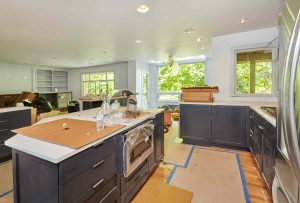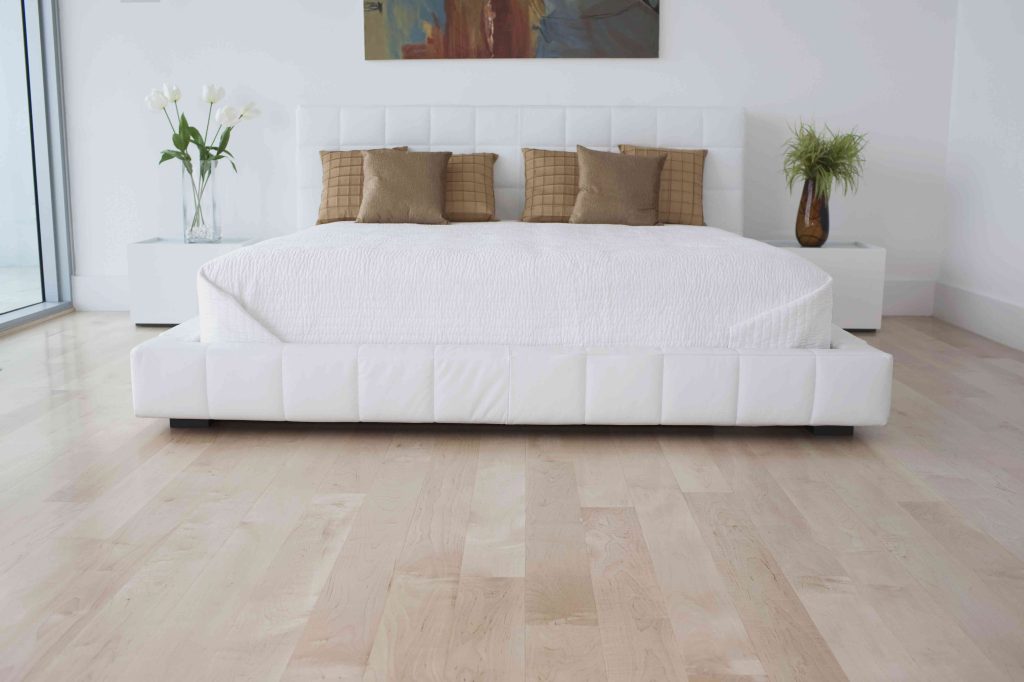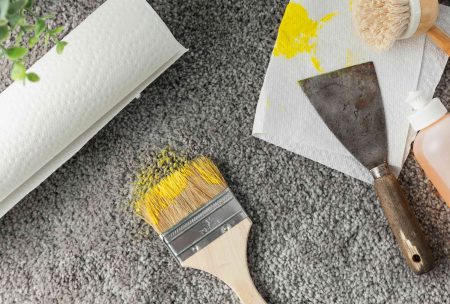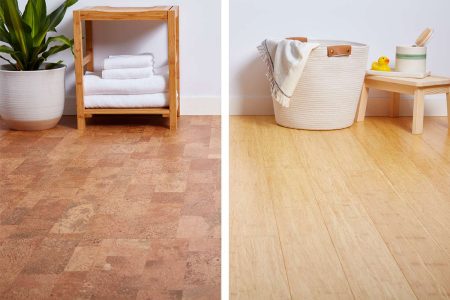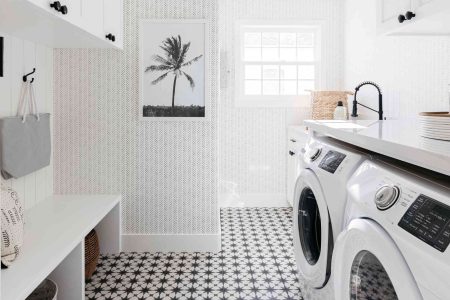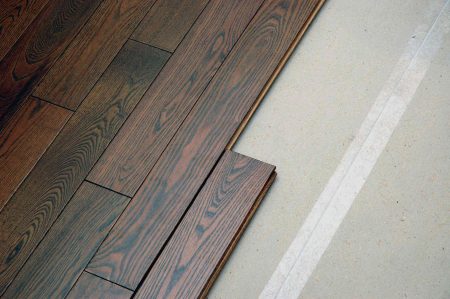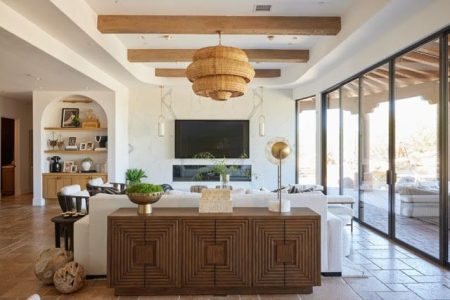The flooring in your bedroom is a particularly intimate surface. It is the first thing your bare feet step onto in the morning and the last thing they touch before climbing into bed each night. The effect that bedroom flooring has on a person is physical and psychological, making your choice of materials a significant design decision. You want it to be comfortable for bare feet, attractive, durable, easy to maintain, and complementary to the bedroom’s decorating style.
One of the biggest questions you may ask is which type of flooring is better. The answer depends on your use. Is it for you, a child, or an older adult? Are you concerned about environmental issues, for instance, does the flooring off-gas chemicals, is it created in a green manner, and will it be recyclable someday when it is time to replace it? Do you plan on selling your home sooner rather than later? Some of these elements may be more important to you than others, but all should be considered when making a flooring choice for your bedroom.
Here are nine flooring materials, including their advantages and disadvantages.
Watch Now: Things to Consider When Choosing Bedroom Floors
Carpeting
Carpet is a prevalent choice for a bedroom flooring surface in North America and many other western nations, mainly because it is soft and warm on the feet—an obvious advantage in a room where you are often bare-footed. That tactile comfort helps to create a sense of lush luxury in many colors and patterns in the room while also dampening sounds and protecting you from cold toes on chilly winter mornings. But there are other reasons that carpet is popular in bedrooms, as well as some reasons you might not want to use it, such as environmental considerations.
Carpet comes in two major categories: cut pile and loop pile. The fiber loops are cut for cut pile, and the fiber loops are left uncut in loop pile carpets. Saxony, textured, and frieze are variations of cut pile carpets, while Berber and level loop are the main types of loop pile carpet. Textured cut-pile carpeting is the most popular type for bedroom use. It’s soft, has a casual look, and resists dirt reasonably well.
-
Thermal insulation: Combined with a good-quality pad, it insulates against heat loss, keeping a room warm
-
Sound-dampening: Absorbs footfalls and outside noises, keeping a bedroom quieter
-
Economical: Can cost $2 to $3 per square foot installed, a considerably cheaper option than most; high-end fibers are more expensive
-
Cushioned surface: Can be safer for bedrooms used by children or older adults; falls are less likely to cause injury; a good-quality pad increases cushioning
-
Difficult to keep clean and allergen free: Liquid can seep deep into padding, remaining permanently; tends to attract dust and small microscopic organisms, affecting air quality; traps pollen and allergens
-
May give off chemicals: May off-gas chemicals, such as formaldehyde, which can cause respiratory issues
-
Short lifespan and usually not recyclable: Shorter lifespan than hardwood and tiles; most is destined for landfills after use
-
Develops wear patterns: After a couple of years of use, lanes of “traffic” may appear in the carpet
Hardwood Flooring
Next to carpeting, hardwood flooring is the most popular choice for bedroom flooring. Among real estate professionals, genuine hardwood is usually regarded as one of the best flooring materials. Not only is it beautiful and hard-wearing, but it’s relatively durable. Even better, it biodegrades and is considered an environmentally friendlier surface. For home resale, hardwood flooring is the best option.
It’s hard to match the natural appeal of real wood flooring, adding beauty to any decor style. While there are dozens of types of hardwood used for flooring, some of the most popular are ash, walnut, oak, and maple. The two basic types of wood flooring are solid and engineered wood. Solid wood floors are full-length pieces of wood from top to bottom, while engineered wood floors are manufactured using three to nine layers of wood veneers.
Strip, plank, and parquet are the three most common wood flooring styles. For bedroom use, strip and plank are by far the most popular. Both are traditional, linear pieces of wood, but the plank is wider than the strip, giving it a more casual vibe.
-
Warmer and softer than tile and stone: Not as soft as carpeting but has some yield; can be combined with throw rugs and area rugs, softening footfalls
-
Buyers prefer hardwood to carpet: Sought-after flooring, homes may sell faster and for a slightly higher selling price
-
Attractive, durable, long-lasting material: Has a warm, natural beauty, varying by wood species and finish; when cared for properly, can last as long as a house; rarely need replacement and can be resurfaced
-
Recyclable material: Old planks can be sold second-hand; recycling centers accept old planks; breaks down naturally
-
Good for people with allergies: Easy to sweep and wipe clean of dust, pollen, and other allergens; ideal flooring for allergy sufferers
-
Maintenance is tricky: Fairly resistant to stains and damage, but when damaged, it can be hard to repair; needs to be sealed occasionally and may eventually need to be stripped and refinished
-
Relatively expensive: Solid hardwood can cost $6 to $25 per square foot, depending on the type of wood; engineered hardwood is a little less expensive
-
No thermal or sound insulation value: Noisy, with no sound absorption, dampening effect, or heat insulation
-
Harder than cork, carpeting, or rubber: Not a fully rigid surface like tile, still a child or older adult on hardwood flooring has higher risk of injury from falls
-
Some hardwoods are not sustainably sourced: Only eco-friendly if it’s ethical and sustainable hardwood flooring from forests that are managed, monitored, and protected
Bamboo Flooring
Bamboo flooring is often lumped in with hardwood flooring since the products are similar in quality and use the same installation methods. However, the bamboo plant is a form of grass, not wood. Bamboo grows very quickly, making it a completely renewable material, and flooring made from bamboo fibers is harder than most hardwoods, making it a very durable flooring.
This easy-to-care-for flooring usually costs less than $5 per square foot for materials, with installation adding about $5 per square foot. At this price, it is comparable to mid-range hardwood flooring. The look is unique. It’s worth checking into bamboo flooring if you are already considering hardwood.
Bamboo flooring comes in strips and planks that fit tightly together, like wood and laminate flooring. There are many grain and color options available.
-
Warmer, softer than tile and stone, contemporary look: Softer and warmer underfoot than tile and stone; combine with throw and area rugs, softens footfalls; clean look in blond, stained, or carbonized tones
-
Durable, long-lasting material: As durable as traditional hardwood flooring, in some cases, harder; can be refinished, depending on the thickness of the planks
-
Eco-friendly and recyclable material: Fast-growing grass available in vast quantities, a rapidly renewable resource; preserves exotic wood species
-
Good for people with allergies: Easy to sweep, vacuum, and wipe clean of dust, pollen, and other allergens
-
Can get scratched: Durable, but can easily get scratched; darker-toned carbonized bamboo flooring is even more susceptible to scratching
-
Relatively expensive: Pricier than carpeting; can cost $6 to $14 per square foot, depending on the quality
-
Quality can vary: Cheaper types are more prone to scratches, dings, and water damage; may be made with toxic resin adhesives
-
Not water resistant: May absorb more moisture than some hardwoods
Cork Flooring
Cork flooring is most often used in kitchens due to its durability and comfortable support when standing for long periods. Although it is still a relatively unusual flooring material, natural cork flooring is used in bedrooms. One of cork flooring’s most important features is its ability to insulate between floors, providing soundproofing and helping keep heat and air conditioning where it belongs.
When stepping onto cork flooring with heels, your shoe will make an indentation into the cork, but the cork particles bounce back after you lift your feet. Over time, heavy furniture can leave permanent indentations. Cork flooring is eco-friendly, available in many colors, and exceptionally durable. It’s expensive, though.
-
Spongy and soft underfoot: A yielding surface, extremely comfortable on the feet; gentle falling surface
-
Insulation value: Filled with millions of tiny air bubbles, offers thermal and sound insulation; warmer than hardwood, though not as cozy as carpeting
-
Easy maintenance: Relatively hassle-free as long as the surface seal is properly applied and periodically reapplied; virtually immune to stains
-
Anti-allergy, anti-microbial: Naturally resistant to microbes and dust-trapping static; much better option than carpeting
-
Less “green” than hardwood: Although made of natural materials, it is manufactured with resins and adhesives that use synthetic chemicals; may not be recyclable but still better for the environment than carpeting, vinyl, or laminate flooring
-
Easily scratched: Relatively soft material that will easily scratch from pet claws, furniture legs, and high heels
-
Shorter lifespan than hardwood: Will have to be replaced periodically, although may be able to be refinished; can last about 25 years.
-
Relatively expensive: Nearly as expensive as hardwood; thicker, higher quality, longer-lasting types cost as much as many hardwood options
Vinyl or Linoleum Flooring
Whether it takes the form of sheet vinyl, vinyl tiles, or newer luxury vinyl flooring (LVF) tongue-and-groove planks, vinyl is a surprisingly versatile flooring choice for bedrooms—no longer just used in bathrooms and kitchens. Many looks are available, with luxury vinyl products almost indistinguishable from wood, ceramic, or stone. Vinyl planks are a good choice for bedrooms. Although not as soft as carpeting, it’s not as hard as hardwood or tile, and breaks falls better. The biggest downside is vinyl is a plastic material; it off-gases chemicals and cannot be recycled.
Vinyl flooring replaced linoleum in the 1970s, but homeowners concerned about the environmental impact of vinyl flooring are starting to return to linoleum. Linoleum, made from linseed oil and other natural ingredients, is the original resilient flooring. It has most of the same virtues as vinyl but is a more environmentally sound choice. Linoleum is slightly more expensive than most types of vinyl flooring, and design choices may be more limited. Still, it is worth looking into if you are considering a resilient flooring material that is 100% biodegradable.
-
Easy to install and maintain: Easy for DIYers to install and is kept clean by sweeping and occasional damp mopping
-
Inexpensive: Vinyl and linoleum costs about $3 to $7 per square foot to install, price varies by quality and if installed yourself
-
Durable and nearly waterproof: Depending on foot traffic, a good quality vinyl or linoleum floor can last 10 to 20 years; water resistance is great for bedrooms with adjoining en suite bathrooms
-
Not a “green” choice: Unless you get linoleum, vinyl is relatively bad for the environment; it’s made with non-renewable petroleum resources; it requires considerable energy to manufacture
-
May off-gas chemicals: New vinyl installations use glues for adhesives that may emit VOCs and hazardous chemicals such as formaldehyde for several weeks after installation
-
Not recyclable: Vinyl is not recyclable and takes centuries to break down; linoleum is a better option and is compostable
Laminate Flooring
Laminate flooring is made from a thin layer of plastic laminate printed with a design layer, bonded to a base layer of high-density fiberboard (HDF), and topped with a clear wear layer or protective plastic coating. It is a remarkably versatile material that can be manufactured to look like almost any material, including hardwood, stone, or even metal.
Laminate is probably the best option for a DIY floor installer as it’s made specifically for easy installation and is a reasonably simple weekend project. It’s also a low-cost alternative, much less expensive than hardwood, and still offers an attractive appearance. Although, it is viewed as a bargain-basement choice when compared to hardwood, porcelain or ceramic tile, or luxury vinyl
Laminate holds up quite well to daily wear-and-tear but is susceptible to scratching and can also buckle if water or other liquids puddle on it. It is almost impossible to repair. You can disassemble and replace individual planks, but it’s more often fully replaced. You can’t refinish it. It doesn’t offer any thermal or sound insulation, although good quality underlayment may help dampen the sound somewhat.
-
Easy to install: Uses a modified form of tongue-and-groove or “click-lock”; one of the easiest flooring materials for DIYers to install
-
Many design choices available: Infinite range of styles and designs, many are good mimics of hardwood or natural stone
-
Inexpensive: Can purchase for less than $3 per square foot, with installation adding $2 to $8 per square foot; only slightly more expensive than vinyl
-
Can be scratched or break: Clear wear layer can get scratched; better quality laminates have thicker, more durable wear layers
-
Hard surface with no sound or thermal insulation: Falls can cause injuries; may not be the best choice for young children or older adults; no thermal protection and tends to echo sound in a hollow fashion
-
Not recyclable: Made from plastic, a non-renewable petroleum product; may take centuries to break down in a landfill
Ceramic or Stone Tile
Ceramic tile and stone are rarely used in bedrooms since they are usually considered too cold, hard, and noisy for the bedroom. Still, ceramic or porcelain tile or stone works beautifully when incorporated with certain decorating styles, notably Mediterranean, Tuscan, tropical, Spanish, or Moroccan themes.
-
Easy to maintain: Does not absorb stains, dirt, or liquids (unless in the grout line); easy to mop or wipe clean; can vacuum or sweep loose debris and dirt
-
Many design choices available: Comes in many colors, patterns, and sizes
-
Durable: Can last up to 20 years or more; in case of severe impact, you can replace damaged tiles individually
-
More affordable than hardwood: Costs $5 to $20 per square foot with installation and depending on the material you choose; cheaper than most hardwood flooring but more expensive than carpet
-
Tiles can get damaged: Clay ceramic tiles can chip, crack, and scratch easier than stone types; all tiles may crumble with time or get loose
-
Hard surface: A fall on a tile floor will hurt and perhaps injure; not the best choice in a bedroom for young children or older adults
-
No insulation value: Tile surfaces are cold and echo sound
-
Grout issues: Grout is porous and can be permeated by moisture and dirt; it can get stained, crumble, and develop mold; in high-traffic areas, needs thorough cleaning
Area Rugs
Although you can layer area rugs over carpet, they are typically used to soften hard floorings, such as wood or laminate. When choosing an area rug for your bedroom, there are endless options of size, color, pattern, weave, and material. It’s easy to change a room’s style, color, or tone by swapping out a different area rug. Also, you can easily roll it up and take it with you when you move.
Your personal preference is the best guide to the right rug for your bedroom: choose one that feels soft and cozy to your feet, has a non-slip backing (if not, place a non-slip pad underneath), adds a dose of style to your bedroom, and complements the overall decorating theme.
While there’s no need to break your budget on an area rug, it’s also true that a good quality rug will generally last longer, look and feel better, and shed less than a cheap bargain brand. In terms of size, if the bed is placed on top of it, the rug should be large enough to extend at least two feet from both sides and the bed’s foot. Smaller rugs used at the base of the bed or along its side should be large enough to fill most of the space. They can help keep a bedroom free from noise.
-
Easy to install and maintain: Rearrange without much hassle; easy to clean when dirty; switch them out, take them with you if you move, or can change the color scheme and style of a room easily
-
Inexpensive: Inexpensive compared to wall-to-wall carpeting
-
Cushioning, sound dampening: Cushions and protects from jolt of cold, hard surface; dampens sound of footfalls
-
Trip hazard: Raised or curled up edges of rugs can cause people to trip, even slip resistant types
-
Non-consistent through the room: Bare feet feel differences of area rug to non-covered floor when moving around the room; look is not consistent
-
Easy to get dirty: Highly trafficked rugs, especially runners alongside a bed can get dirty quicker than most
Rubber Flooring
Rubber flooring is made of virgin or recycled rubber. This type of flooring is durable, sometimes lasting for more than 30 years, and can be an excellent alternative for a child’s bedroom or playroom. It can stand up to dropped weights and is less likely to scuff, dent, wear, or tear. Besides its durability, it’s also easy to clean and maintain. It comes in a wide range of colors, and styles, including tile and sheet versions and flat or patterned looks.
Rubber is resistant to fire and burns and is non-toxic when burned. Rubber is manufactured from renewable rubber sap harvested from rubber trees without harming the tree or the environment. Recycled rubber floors are made from rubber car tires, saving them from going to landfills.
-
Spongy and durable Extremely comfortable on the feet; safer flooring for falls than most; Can stand up to dropped weights; can last for up to 20 years or more
-
Insulation value: Spongy quality muffles loud noises and the sound of footfalls
-
Easy maintenance and anti-microbial: Easy to wipe up spills and sweep away dirt; Naturally resistant to bacteria, fungus, mold, and other allergens
-
Eco-friendly: Made from rubber sap without harming the environment; non-toxic if burns
-
Slippery when wet: Slippery when wet; water can permeate the seams and get down to the subsurface
-
Cheap look: Works well for gyms and playgrounds, aesthetically it can leave something to be desired for bedrooms
-
Rubbery smell: Rubber has a characteristic odor that some people do not like
-
Relatively expensive: More expensive than ceramic tiles; costs upwards of $10 per square foot
Read the full article here
